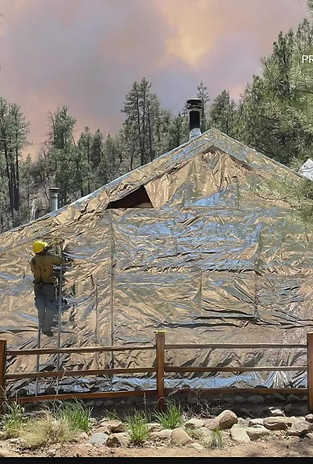Service at Palace Station
Troop 109's
History of Palace Station, AZ
Palace Station History is provided by the Prescott National Forest
Palace Station is one of the few remaining stagecoach stations dating from the settlement of the Arizona Territory and portrays the lifestyle of the hardy pioneers who sought new opportunities, fortunes and freedoms in the post-Civil War migration to the West. The station played an important role in the social and economic development of the new territory and is now a public property listed on the National Register of Historic Places.
The surrounding Bradshaw Mountains were first settled in the 1860’s by prospectors in search for gold and other valuable minerals. Among the first to explore these mountains was William D. Bradshaw, a miner, who arrived in Arizona from California in 1863. The Indian Wars of the 1860’s and 70’s claimed the lives of many of these local pioneers. Mines and homesteads in the area were raided for livestock and wagon trains attacked for supplies by Apache war parties. These depredations were ended by General George Crook, who used this location as a bivouac area for his troopers while scouting in the area, and whose accomplishments are memorialized by the name of this rugged canyon.
In 1873, Alfred B. Spence, his wife Matilde, and his father-in-law, R J. Lambuth, arrived in Arizona Territory from Missouri and settled on Groom Creek where they operated a sawmill. In 1875, they moved to Crooks Canyon and constructed the log house which is still there today.
This location was selected because it was halfway between Prescott and the Peck Mine, which at the time was one of the most prominent mines in the Territory. The original log structure was built in the manner typical of pioneer cabins and had two downstairs rooms and a sleeping loft. In 1890, when sawed lumber was more readily available, the board and batten kitchen was added. With the exception of the rear porch, which was not a part of the early construction, the Station retains its original form. Most of the original structure remains, although some elements, such as the log chinking and daubing, roof shingles and porch are replications of the original work. Three barns, a bunkhouse, milk house, blacksmith shop and henhouse no longer remain.
At the time of the Spences’ arrival here, the only access route into Crooks Canyon was a mule trail. The Senator Road from Prescott went only to the Senator Mine, approximately 6 miles north of here. In 1877, a wagon road was surveyed into the canyon and, thereafter, the Prescott to Phoenix stage carried passengers to Palace Station and beyond to the Peck Mine. At Palace Station, the horses were watered and rested while the travelers enjoyed a meal prepared by Mrs. Spence. Horses were changed at Bully Bueno, another station 6 miles southeast from here. The trip from Prescott to the Peck Mine was completed in a single day and thus Palace Station did not provide sleeping accommodations for the stage riders. Wagon freighters, miners on foot or horseback, and mule skinners with pack trains carrying ore or supplies comprised the majority of overnight guests. Behind the Palace Station bar a sign offered meals for $0.50, beds for $1.00 and hay and grain for $1.50.
In 1900, a new and improved road was opened. Unlike the original train, which followed the creek bed, the new road was suitable for buckboards and enabled travelers to journey into the Bradshaws without need for the stage. About the same time telephone service was introduced into the area and the improved communications further reduced the role of the stage. The first automobiles began to travel the road in about 1910.
The Spences raised six daughters, two sons, and two grandchildren here. Since the nearest school was in Goodwin, 4+ miles away, all of the children were schooled at home by Mrs. Spence.
Albert Spence died in 1907 and Mrs. Spence sold Palace Station in 1910. Subsequently, in 1963, Palace Station came into the public domain of the Prescott National Forest.
Each year since 1981, except 2020, Troop 109 has done numerous service projects. With the scouts’ hard work, some of these projects include; the clearing of overgrown shrubs, fence repair, new flagpole, improved the helipad, maintained trails and has served as the site for the “Paul Bunyan” project.
The Early Years of Troop 109 at Palace Station
Author: 12News Phoenix
Published: 11:14 AM MST April 25, 2022
Updated: 6:16 PM MST April 25, 2022
PRESCOTT, Ariz. — The U.S. Forest Service is trying to protect one of Arizona's oldest known structures from falling victim to the Crooks Fire that's been burning around Yavapai County.
The federal agency recently shared photos of fire crews wrapping protective foil around the Palace Station, a stagecoach cabin that dates back to the 1870s, in an attempt to shield the historic structure from the Crooks Fire. Click on the photo to view the entire video from 12NEWS







